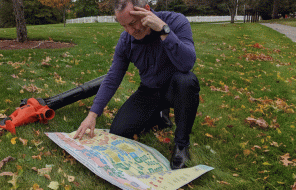Disrupting Acquisition Blog
You Should Make A Video
By Dan Ward & Deb Zides
Hardware assembly instructions are notoriously difficult to follow. Sometimes it’s because the words and pictures on the page were badly written, poorly labeled, or visually ambiguous. Other times the hardware itself is simply challenging to put together, perhaps because the function of some components is hard to discern, or perhaps because the box is full of components that look identical but have subtle differences which only become apparent once they have been installed incorrectly.
 We both encountered this situation over a recent long weekend. Dan was putting together a large hinged outdoor storage box. Deb was assembling a leaf blower / vacuum. Both items took us longer than we anticipated, and we both ran into frustrating dead-ends that exceeded our problem-solving skills. It wasn’t just that the unintelligible, verbose, black-and-white, two-dimensional pages needed to be flipped back-and forth repeatedly, but also the “minor detail” assembly note that an Allen wrench was needed to unlock a part of the system in Step D but not identified as a needed tool until Step Q.
We both encountered this situation over a recent long weekend. Dan was putting together a large hinged outdoor storage box. Deb was assembling a leaf blower / vacuum. Both items took us longer than we anticipated, and we both ran into frustrating dead-ends that exceeded our problem-solving skills. It wasn’t just that the unintelligible, verbose, black-and-white, two-dimensional pages needed to be flipped back-and forth repeatedly, but also the “minor detail” assembly note that an Allen wrench was needed to unlock a part of the system in Step D but not identified as a needed tool until Step Q.
It’s worth pointing out that we both have engineering degrees and 20+ years of military service, so the idea of using tools and following directions are not exactly alien to us. Nevertheless, we both struggled to complete these projects. No doubt the instructions made perfect sense to the writers, but they were often unintelligible to us mere consumers.
Interestingly, we solved our problems the same way – by watching YouTube assembly videos. In both cases, we found quick, amateur tutorials that provided step-by-step walk through procedures which were far better than the professionally printed instructions. The hand-held video might have been shaky, the explanations unscripted and unpolished, the audio quality uneven, but the combination of moving pictures and verbal commentary is powerful. Watching a person say <this> goes <here> just like <that> and be careful about <those> made all the difference. Dan particularly appreciated the comment at 2:21 in his video where the gentleman says “what the heck is this bar, it’s really hard to put in and the written directions are not very clear…” Yup, that’s why we watched the video in the first place.
 How long did it take and how much did it cost the YouTube video owner to create those tutorials? Probably less than an hour each, including time for edits and retakes. On the other hand, how much did the manufacturer spend to develop, review, approve, translate into multiple languages, print, fold, and finally insert the directions into the packaging? Probably months worth of effort.
How long did it take and how much did it cost the YouTube video owner to create those tutorials? Probably less than an hour each, including time for edits and retakes. On the other hand, how much did the manufacturer spend to develop, review, approve, translate into multiple languages, print, fold, and finally insert the directions into the packaging? Probably months worth of effort.
Naturally, this got us thinking about defense acquisition policy.
When the Middle Tier of Acquisition pathway was established, each of the services published detailed implementation instructions. Those instructions were fine as far as they go, but like all such things, caused a certain amount of confusion among readers. Concepts and procedures which seemed unambiguous to the policy authors ended up interpreted in different ways by the practitioners in the field. Further confounding the issue was the fact key information was distributed across in several sources – the equivalent to having not just one set of assembly instructions, but references to multiple instructions, guides, toolsets, and requirements in order to assemble some new gadget.
 In conversations with program managers, logisticians, engineers, and contracting officers, as well as with our MITRE colleagues, we fielded a lot of questions about how exactly this new MTA thing was supposed to work. Clearly, we needed a richer communication channel, something closer to a tutorial video instead of printed assembly instructions.
In conversations with program managers, logisticians, engineers, and contracting officers, as well as with our MITRE colleagues, we fielded a lot of questions about how exactly this new MTA thing was supposed to work. Clearly, we needed a richer communication channel, something closer to a tutorial video instead of printed assembly instructions.
We quickly put together a short interactive presentation and took it on the road – sort of a live-action, in-person alternative to a video. We shared our presentation with our colleagues at MITRE, as well as a handful of program offices, an Acquisition Officers Association meeting, and a couple DAU classrooms. It seemed to do the trick. Now the concept has been taken to the next level by an innovative military Program Manager with support from the DAU senior leadership. He’s crowd-sourcing the development of a new DAU PMT course to help acquisition practitioners understand and apply this new authority. They’re going to make some videos. And yes, we’re both participating in this educational experiment.
Why are we bringing this up? Well, the DoD is about to launch a re-write of the 5000-series policies, which means we’re about to see a whole bunch of new instructions on how to put together an acquisition program. Like other forms of written instructions, there will almost certainly be some confusion and ambiguity about what exactly we’re all supposed to do.
That’s why we’re challenging the acquisition community to create a series of video tutorials and/or podcasts to help unpack and assemble these new policies. These videos do not require high production values, they don’t need to take much time to produce. They simply have to share a lesson, an insight, or an example of how these policies work in real life.
 Got something to say about intellectual Property? Other Transaction Authority? Middle Tier of Acquisition strategy documentation? The new software acquisition pathway? Great – please do everyone a favor and create a video tutorial or podcast to share what you know with the rest of the community. If you’re looking for an example of what we’re talking about, watch a few installments of the Rapid Innovation Video Course that Dan put together. It’s a collection of 22 low-res talking head style videos, each approximately 3 minutes long. We promise, you can do this.
Got something to say about intellectual Property? Other Transaction Authority? Middle Tier of Acquisition strategy documentation? The new software acquisition pathway? Great – please do everyone a favor and create a video tutorial or podcast to share what you know with the rest of the community. If you’re looking for an example of what we’re talking about, watch a few installments of the Rapid Innovation Video Course that Dan put together. It’s a collection of 22 low-res talking head style videos, each approximately 3 minutes long. We promise, you can do this.
The good news is you don’t have to start from scratch or make your own video channel. There are plenty of podcasts out there just waiting for you to be a guest. Earlier this summer we did exactly that when we appeared as guests on a MITRE podcast as part of our work spreading the word on new acquisition policies. It’s called the MITRE Knowledge-Driven Enterprise (KDE). All we had to do is show up with knowledge, while the host took care of recording and posting. Not a bad deal.
Video tutorials are a gamechanger in the area of homeowner weekend projects. They can be gamechangers for defense acquisitions too, particularly in this current period of change. As you experiment with these soon-to-be-released policies and pathways, we invite you to spend a little time sharing what you learned with the rest of the acquisition community. Make a video, tell your story, and pass it around. Imagine if everyone did this – how much would that accelerate innovation, provide feedback up down and sideways, and help make the policies and guidance more and more relevant to program execution needs.
And yes, we’re going to make more videos too. Watch this space for links in the near future!
Subscribe to Our Newsletter


0 Comments